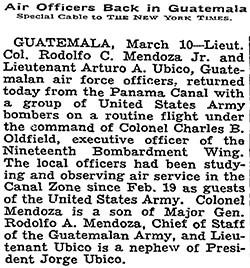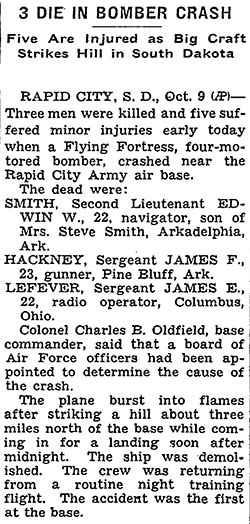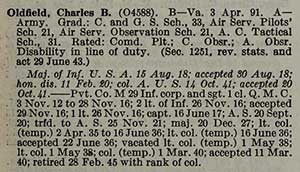|
As you might imagine, just about every guy named Oldfield got the nickname "Barney" if they were of a certain age. The namesake, the original Barney Oldfield, was a racing automobile driver during the early 20th century. If you search for our pilot Oldfield using "Barney" in the search phrase, be warned that you will find many, many links to the famous automobile driver. As well, there was another Barney Oldfield who was a Hollywood publicist and non-aviator aide to Dwight Eisenhower during WWII. He's not our Oldfield either, but he will certainly show up in your Web searches.
Our Charles Belding "Barney" Oldfield, Jr. was born April 3, 1891. I know little about his early life, except through U.S. Census data. From the Census, we learn that he completed high school and three years of college.
Oldfield joined the Army in 1917 and earned his wings in 1921, at a relatively old age (29 or 30) for an Army pilot. Early on he flew around the country with Army aircraft. An anecdote from Muskogee, OK is indicative. It describes Oldfield giving a nickname to the local Will Field. "Hatbox Field was first called Witt Field until Capt. Charles B. Oldfield observed from the air that the tin-roofed hangars, with walls painted in a vertical black-and-white striped pattern and the roofs a black-and-white checkered design, resembled a 'lady's hatbox.'"
Among other things, he had an interesting early flying life. On July 22, 1922, he crashed a deHavilland DH-4B, AS-62965, at Post Field, Ft. Sill, OK. Crashes didn't deter him, as evidenced by the experience below from 1925. I include the entire text because I'm not sure of the longevity of the link. The source, published online October 23, 2010, is at the link, along with the cartoon that follows below the boxed article. The location was near Portsmouth, ME. Note mention in the article of two Davis-Monthan Register pilots, Jimmy Doolittle and Louis R. Knight.
"The ground under the tiny wooden Town Hall in Eliot, Maine shook twice on Wednesday, January 7, 1925. Shortly after 8 am the strongest earthquake residents could recall knocked pictures off the walls. Around 12:30 that afternoon a De Havilland bi-plane crashed into the corner of the 1 1/2 story municipal building.
Army pilot, Charles Benning Oldfield, not to be confused with the then famous racecar driver, Charles Barney Oldfield, had been making a run from Mineola, NY to Boston. Flying at an altitude of 2000 feet he suddenly encountered a thick fog that caused him to lose his bearings and drift further north than he had intended.
"Aviators navigated by sight in 1925 and Oldfield couldn’t see a thing from his open cockpit situated just behind the wings. He was spotted flying alarmingly low over Portsmouth Navy Yard just after noon, having dipped below the fog in an attempt to find a place to land. By the time the experienced Army pilot aimed for Everett Hammond’s field in Eliot his engine was dead. He was out of gas.
Gliding in the rest of the way, Charles overshot the edge of the field barely missing a stone wall. He slammed into the corner of Town Hall piercing the Selectman’s Office. Luckily, nobody was in the building when wood, plaster and glass sprayed in all directions. A 300 pound safe was knocked clear across the room, remembered Ralph E. Dixon in the 1988 book A View of Eliot’s Past by Edward H. Vetter. Captain Oldfield was not seriously injured but the impact splintered the propeller and cracked the radiator of the U. S. Army airplane that had been entrusted to him.
"Students at the high school 300 yards away heard the crash. Despite a stern warning from his teacher, Carleton Staples jumped out of his classroom window and ran over to get a closer look at the disabled bi-plane. He never regretted that particular defiance and proudly told the story for many years.
Word got around. Before long, people came from all over town and from across the Piscatiqua River to bear witness. One of them was the reporter for the Portsmouth Herald who chronicled the events that followed the crash. Guards were stationed around the plane to keep onlookers at bay while Charles Oldfield went to telephone Captain Louis R. Knight of the Army Air Service.
"Arrangements were made for De Havilland expert and daredevil aviator Jimmy Doolittle to fly in from Boston the following day to assess the damage. Charles retired to Portsmouth for the night where he was greeted as a celebrity. “Captain Oldfield,” wrote the Herald reporter, 'in his enforced stay in this vicinity created a good impression with those whom he met, he being a genial type of man and an interesting conversationalist.'
"Jimmy Doolittle flew to Eliot on Thursday morning. It took him just a few minutes to formulate a repair plan and he was back in Boston by noon to order the necessary parts. Two accomplished aviation mechanics were dispatched from Boston in a truck with a propeller, a radiator, several sturdy timbers and more than enough fuel to get the damaged plane back to Boston. Local people remarked on the impressive speed and skill with which these highly specialized mechanics installed the replacement parts but they were just finishing up when the January sun called it a day.
"A crowd arrived at the Town House on Friday morning to watch Oldfield depart but there was still a major obstacle to overcome. The opening in Everett Hammond’s stone wall was way too small to squeeze an airplane through. All day Friday was spent trying to get the bi-plane back into the meadow for takeoff. The timbers brought from Boston were fashioned into a ramp of sorts but in the end the plane had to be hoisted over the wall with the help of Eliot men who had gathered to watch. Finally at 4 pm Captain Charles B. Oldfield boarded his plane and lifted off. He circled the field twice to make sure the engine was sound and with a tip of his wing to the good people of Eliot, he was gone.
"When all the excitement died down attention turned to the damaged Town Hall. The little building that had once served as a school was in need of expensive repairs. Two weeks after the accident it was reported in the New York Times that the Town of Eliot was seeking compensation from the Federal Government. The War department forwarded the claim to Mineola, NY and Major Stillwell of the Fifth Infantry stationed at Portland, ME was ordered to Eliot to investigate. Evidence that the damage was caused by the Army bi-plane was irrefutable.
"A special thanks to Peggy Elliott at the William Fogg Public Library in Eliot, Maine for her able assistance. She reports that the little Town Hall, which was located across State Road from where Eliot Elementary School now stands, was torn down in the 1970s." |
Below, a sketch that accompanied the article above. It is not clear from the link whether this drawing was from 1925, or from 2010. I think the latter, because similar drawings accompany other articles at the link.
Cartoon of Oldfield's Reception at Town Hall, Wednesday, January 7, 1925 (Source: Link)
 |
Subsequent to this excitement, Oldfield is discovered with another Register pilot, Elmer D. Perrin. According to Perrin's pilot log book, he carried Oldfield as a passenger on December 11, 1925. Please direct your browser to Perrin's Web page and you'll find Oldfield cited on page 42 of Perrin's pilot log book #3.
Five months later, Oldfield landed twice at Tucson, each time in military aircraft. His first landing was on Wednesday, April 7, 1926 at 4:50PM. He carried passenger he identified as Pvt. Riley. They flew a deHavilland DH-4M2, 30-885. Based at San Antonio, TX, they were westbound from El Paso, TX to Yuma, AZ. They remained overnight, departing the next day at 8:00AM.
His next visit was the next day, flying the same airplane. He carried a passenger he identified as Lt. McKinnon. They were eastbound from Yuma to El Paso, thence probably back to San Antonio. Arriving at 1:45PM, they remained on the ground until 2:30PM before continuing east. This round-robin flight from base to destination and back carrying specific passengers was common among the military pilots who signed the Register.
His final landing was nearly three years later on Saturday, June 22, 1929 at 1:20PM. This time he and his passenger, Sgt. Groves, were westbound from Marfa, TX to Riverside, CA, probably March Field. They flew in the Douglas O-2K Oldfield identified as 29-205. No reason was given for this or any other of his flights through Tucson.
Oldfield also landed once as a passenger with Register pilot Charles "Bill" Gilpin. He landed with Gilpin on Tuesday, February 19, 1929. They were westbound to Los Angeles, CA (probably Grand Central Air Terminal [GCAT] where Gilpin was based) from Lordsburg, NM. Gilpin carried both Oldfield and fellow Army officer Major Monte Stone (not a Register pilot). Gilpin operated Gilpin Airlines out of GCAT and was probably transporting the officers as civil passengers.
Oldfield in Life Magazine, January 25, 1937 (Source: Life)
 |
As mentioned earlier, other than U.S. Census data, I have very little information about Oldfield's life. He did have a responsible presence in the Air Corps before and during WWII and for a couple of decades after. During the late 1930s, he commanded Gray Army Airfield at Ft. Lewis, WA. During one air show there, "The field’s commander, Lieutenant Colonel Charles B. Oldfield... greeted visitors and explained air power to interested citizens."
About this time, Oldfield appeared in Life Magazine in the January 25, 1937 issue, left. He was identified as commander of the 2nd Bombardment Group at Langley Field, Virginia.
For context, this article was titled, "Four Types of Planes Carry the U.S. Army Into the Air." The opening paragraph was a saber-rattling riff on the development of the U.S. Army Air Force from the time of the first Wright Flyer to the late-1930s metal, low-wing fighters and trainers with speeds approaching 300MPH. The four types were identified as attack, bombardment, pursuit and observation. Oldfield represented the bombardment category, and is pictured in the cockpit of a Martin B-10.
The New York Times, March 11, 1941 (Source: NYT)
 |
Also, the article from The New York Times, right, from March 11, 1941 alludes to early, pre-war activites with heavy bombers in the Panama Canal Zone. On this date Oldfield was commander of the 19th Bombardment Wing.
The New York Times, October 10, 1942 (Source: NYT)
 |
Then, early during WWII, he commanded the Rapid City S.D. Army Air Base. The article, left, from The New York Times of October 10, 1942 describes one of the grim tasks of the base commander.
The New York Times, September 17, 1961 (Source: NYT)
 |
Three children were born to Colonel Charles Belding Oldfield Jr. and Marguerite Illing Oldfield. All children traveled with the family while Oldfield established and commanded Army Air Corps training bases in Dodge City KS; Boise, ID; Rapid City, S.D; Fort Lewis, WA; San Antonio TX and the Panama Canal Zone. During WWII, the family resided in Little Rock, AR with their uncle Leo Oldfield, and after the war, returned to Virginia.
The U.S. Census for 1940 documents Oldfield, age 48, living with his wife Marguerite (47), son Charles B. (III?) age 11, and two daughters, Marguerite (8) and Katharine (6). They were based at the Ft. Lewis, WA military reservation. His occupation was "Officer, U.S. Army." According to that record, he had completed three years of college.
U.S. Army Retirement List, Late 1940s (Source: Woodling)
 |
According to the U.S. Army retirement list, above (courtesy of Bob Woodling), Oldfield retired February 28, 1945 (before the end of WWII) with the rank of colonel. His record states he suffered a disability in the line of duty.
During his retirement it appears he maintained a role in the modern Air Force. The article at right from The New York Times of September 17, 1961 illustrates a minor watch dog incident.
Despite his disability, Oldfield enjoyed a 40-year retirement. After his retirement from the Air Force, Oldfield went on to earn a law degree at the age of 50 and practiced law for a number of years. A lifelong student, he was pursuing a degree in both accountancy and philosophy when he died at age 93.
He died at 3:43AM, January 22, 1985 in the Naval Hospital at Portsmouth, VA. According to his death certificate, he died of sepsis consequent to pneumonia. He is buried at Arlington National Cemetery.
Dossier 2.1.198
---o0o---
UPLOADED: 09/27/15 REVISED: 10/09/15
|







